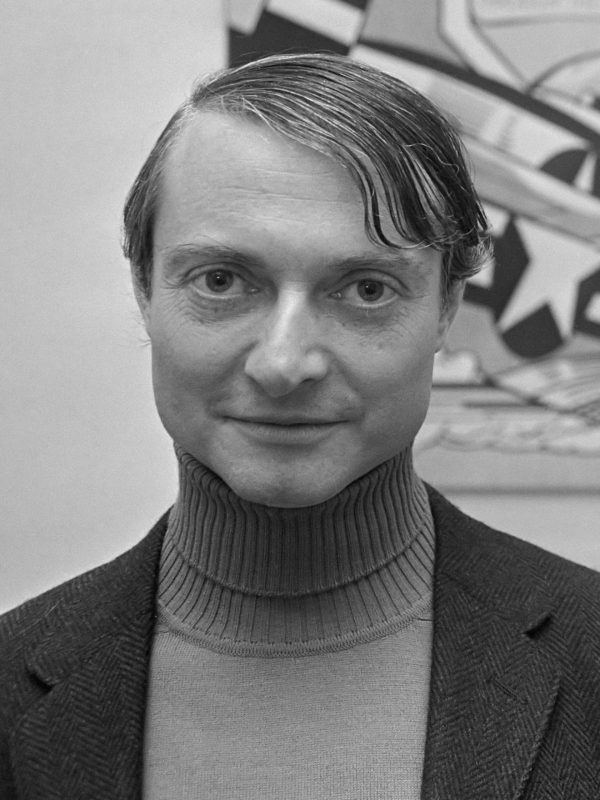Biography
Roy Lichtenstein was the master of the stereotype, and the most sophisticated of the major Pop artists in terms of his analysis of visual convention and his ironic exploitation of past styles. The work for which he is now known as the product of a long apprenticeship.
He was born in New York City in October 1923. His parents were middle-class and he described himself as having had a quiet and uneventful childhood. Though art was not taught as part of the curriculum at his high school, in his junior year he started to draw and paint as a hobby. His first subjects were jazz musicians (the product of youthful enthusiasm for their music), and his work was affected by Picasso’s Blue and Rose Period paintings, which he knew from reproductions.
In his last year of high school, 1939, he enrolled for summer art classes at the Art Students’ League under Reginald Marsh. His subject matter was then strongly influenced by Marsh’s own work. On his graduation from high school, Lichtenstein decided to leave New York and study art. He went to the School of Fine Arts at Ohio State University, but his artistic education was interrupted by the war. He was drafted in 1943 and served in Britain and continental Europe. During his time in the services, he was able to do some work as an artist, particularly drawing from nature. Demobilized in 1946, he returned immediately to Ohio State University and gained his Bachelor of Fine Art in June. He then joined the graduate program, as an instructor. In 1949 he gained his Master of Fine Art and held his first one-man exhibition at the Ten Thirty Gallery in Cleveland. At this time he started to introduce broad references to Americana in his work: in 1951 he had a show in New York consisting largely of assemblages made of found objects. He moved to Cleveland and worked on and off as an engineering draughtsman for various companies while continuing to paint and intermittently show his work in New York. His earliest proto-Pop work was painted in 1956 – a picture of a dollar bill – but it had no immediate successor. From 1957 until 1960 his work could, broadly speaking, be classified as Abstract Expressionist he had previously passed through Geometric Abstraction and a version of Cubism.
In 1960 Lichtenstein was appointed Assistant Professor at Douglas College at the Rutgers University of New Jersey, which put him within striking distance of New York. He met and had long discussions with Allan Kaprow, and he also met Claes Oldenburg, Jim Dine, Lucas Samaras, and George Segal. He attended a number of early ‘Happenings’, but did not participate in them actively. These contacts revived his interest in Pop imagery, and a more immediate stimulus was provided by a challenge from one of his sons, who pointed to a Mickey Mouse comic book and said; ‘I bet you can’t paint as good as that.’ In 1961 Lichtenstein produced about six paintings showing characters from comic-strip frames, with only minor changes of color and form from the original source material. It was at this time that he first made use of devices that were to become signatures in his work – Ben-Day dots, lettering, and speech balloons.
Lichtenstein took in his comic-strip paintings unannounced to the new Leo Castelli Gallery and was almost immediately accepted for exhibition there, in preference to Andy Warhol, who had started doing similar work. His first one-man show with Castelli in 1962 launched him on a career that was thereafter uniformly successful. In 1963 he moved from New Jersey to New York, having taken leave of absence from his job at Rutgers; in 1964 he resigned from teaching altogether. In 1966 he showed at the Venice Biennale, and in 1969 he was given a retrospective at the Guggenheim Museum, which later toured America. He was elected to the American Academy of Arts and Sciences in 1970 and then moved to Southampton, Long Island, thus following a pattern set by many successful American artists.
Lichtenstein’s development as a mature painter was marked by his propensity for working in successive series or thematic groups. The later groups tended to be interpretations and to some extent parodies of earlier Modernist styles – Cubism, Futurism, and Surrealism. In the early 1980s, Lichtenstein created sculptural maquettes constructed from flat shapes as three-dimensional graphic imitations of German Expressionist woodcuts. These, like his series of painted or sculpted brushstrokes of the 1980s, painstakingly created an ironic suggestion of spontaneity. In the late 1980s and early 1990s, he returned to the use of Ben-Day dots in a new and refined application of his earlier style. Roy Lichtenstein died in September 1997.

